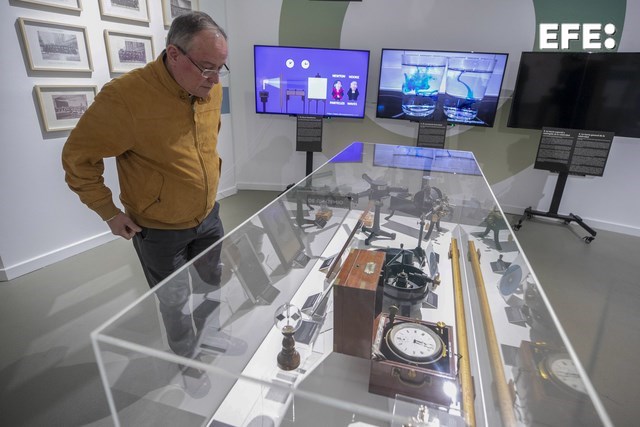Zaragoza (EFE) Albert Einstein made the Aragonese capital between March 12 and 14, 1923.
The exhibition ‘Einstein and Aragonese science’ occupies two spaces in the Auditorium. The first, the Jorge Cocci room, includes in its exhibitors a tour of Einstein’s passage through the Aragonese capital, among them, texts from the press of the time, as well as “authentic treasures”, such as original articles by the scientist dating from 1905, in which he laid the foundations of his prodigious career, or offprints from his 1913 works.
The room also displays publications by great names in science, from Euclid to James Maxwell through Isaac Newton and Riemann’s geometry, closely linked to the work of Einstein. In addition to a review of Spanish science at that time, a ‘silver age’ that had exponents such as Santiago Ramón y Cajal from Aragon.

The visit was no coincidence
In fact, as the coordinator of the exhibition, Pedro Miana, has recounted, his visit to the city was not a “chance”, since he knew Spanish colleagues and was invited by the Faculty of Sciences and the Royal Academy of Sciences of Zaragoza.
In his twenty-day tour of Spain, in addition to the Aragonese capital, Einstein also visited Madrid and Barcelona, after a long five-month journey through Asia and before returning to Germany.
Thus, the exhibition also includes the photos and correspondence that the creator of the theory of relativity maintained with Aragonese scientists such as Casimiro Lana, Jerónimo Vecina or Manuel Lorenzo.
Similarly, in the Jorge Cocci room there is also space for criticism, with documents from the time that cast doubt on Einstein’s research, which in Spain found detractors such as Julio Palacios from Aragon.
Greeted like a rock star
In the exhibition there are also articles and photographs that reflect how the genius was received in Spain “like a rock star”, Miana has compared.
In the exhibition space, the figures of Gregorio Rocasolano, Casimiro Lana and Jerónimo Vecina, closely linked to the visit that the scientist made to the city, are also reflected with various objects and texts. Precisely, in the Museum of Natural Sciences, in the Odón de Buen room, the exhibition continues with those letters and photographs that he shared with his Spanish colleagues, a space that also shows the minutes book of the IES Goya, then Technical Institute, which accredits Einstein’s passage through its facilities.
A map of Zaragoza from 1923, various laboratory objects from the time and explanatory videos on three screens are part of what is included in the exhibition at the Museum of Natural Sciences.
an interactive avatar
In addition, the exhibition includes an interactive avatar of Einstein that answers questions related to this proposal, created by the company Imascono in collaboration with the Art and Technology Center (Etopia) of the city council of the Aragonese capital.
The sample has had the collaboration of more than twenty public institutions, among them, the Ebro Hydrographic Confederation, the IES Goya and the Faculty and the Royal Academy of Sciences, and the support of the families of some of the scientists who were present on the 1923 visit.







Wow, marvelous weblog layout! How lengthy have you ever been running a blog for?
you make running a blog look easy. The entire glance of your site is great, let alone the content material!
You can see similar here sklep online
It’s a shame you don’t have a donate button! I’d certainly donate to this superb blog!
I guess for now i’ll settle for bookmarking and adding your
RSS feed to my Google account. I look forward to new updates and will share this
site with my Facebook group. Talk soon! I saw similar here: Sklep online
Good day! Do you know if they make any plugins to assist with SEO?
I’m trying to get my blog to rank for some targeted keywords but I’m not seeing very
good success. If you know of any please share.
Many thanks! You can read similar art here: E-commerce
It’s very interesting! If you need help, look here: ARA Agency
Hey! Do you know if they make any plugins to assist with
Search Engine Optimization? I’m trying to get my website to rank for some targeted keywords but I’m not seeing very good gains.
If you know of any please share. Thanks! I saw similar text here:
Auto Approve List